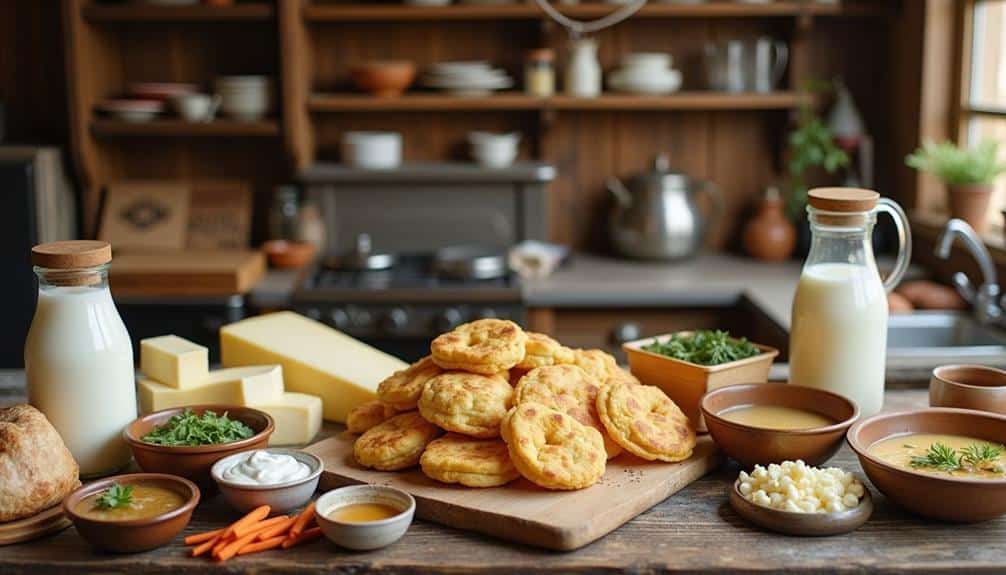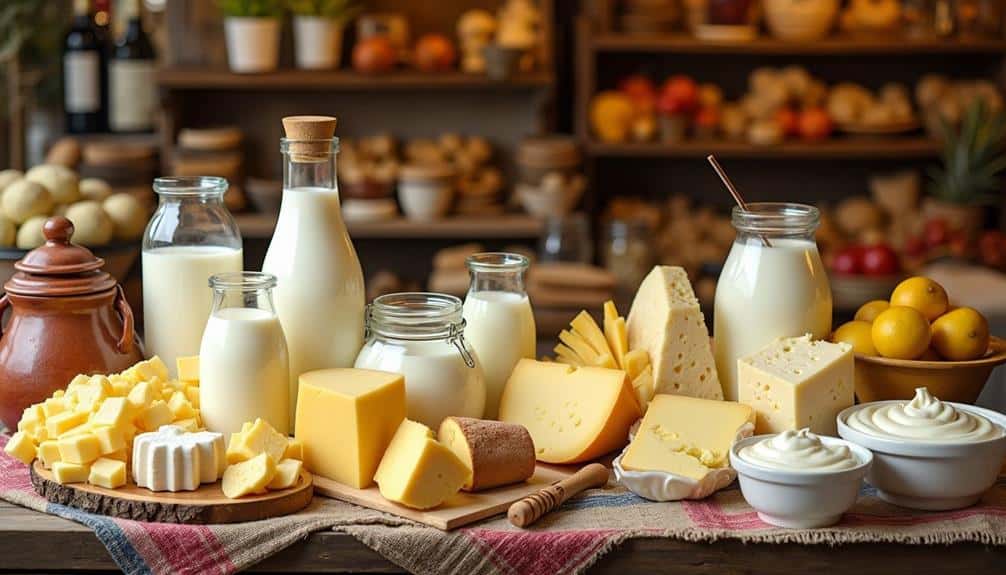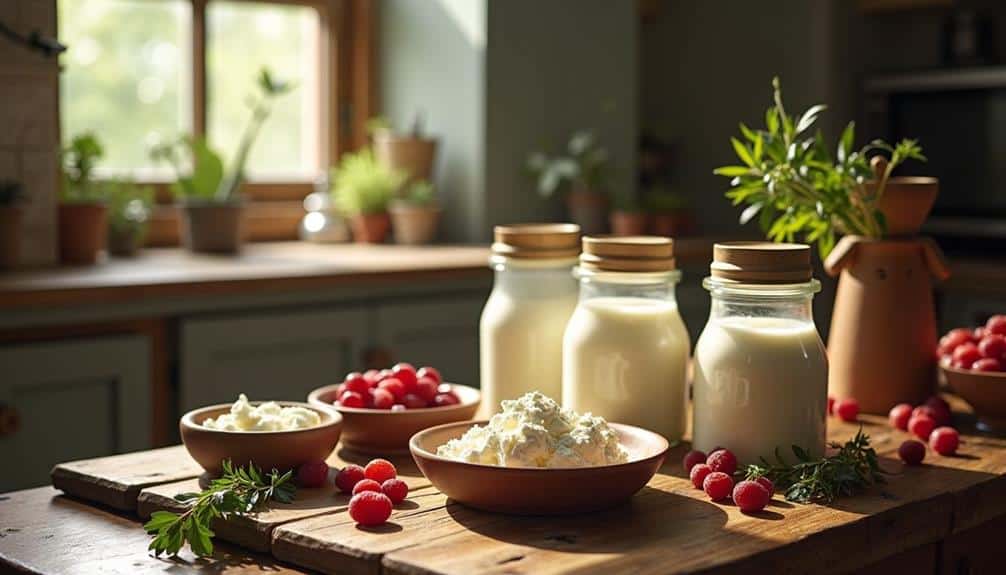Russian cuisine’s enduring passion for dairy is woven deeply into its cultural and historical fabric. From the ancient Slavic reliance on milk and its derivatives for nutrition, to the elaborate Tsarist-era feasts featuring butter and artisanal cheeses, dairy products symbolize prosperity and hospitality. Celebrated through festivals like Maslenitsa, dishes such as borscht with smetana (sour cream) and blini showcase dairy’s central role. Russian dairy products, including kefir, ryazhenka, and tvorog, are not only culinary staples but also rich in health benefits. This creamy culinary journey reflects Russia’s unwavering appreciation for dairy, inviting further exploration into its rich traditions.
The Importance of Dairy in Russian Cuisine

Dairy products are indispensable in traditional Russian dishes, with staples like sour cream enriching borscht and blini.
Tvorog features prominently in desserts and breakfasts.
Historically, dairy played a vital role in Russian life, from the peasant households churning butter to the artisanal cheese-making practices preserved through generations.
This deep-seated cultural significance highlights dairy’s essential place not only in Russian cuisine but also in its rich historical tapestry.
Dairy as a staple in traditional Russian dishes
A cornerstone of Russian cuisine, dairy products feature prominently in both everyday meals and festive dishes, reflecting the country’s rich agricultural heritage and culinary ingenuity. Dairy festivals across Russia celebrate this heritage, showcasing regional specialties and innovative uses of dairy. For instance, the famous Blini, thin pancakes traditionally paired with sour cream, highlight the crucial role of dairy in Russian gastronomy.
In a chronological analysis, dairy’s significance can be traced back to ancient Slavic communities, where milk and its derivatives were essential due to their nutritional value and versatility. Over time, dairy innovations such as the fermentation of kefir and tvorog (a type of cottage cheese) have become staples, enriching the culinary landscape.
Traditional pairings like pelmeni (dumplings) served with sour cream, and borscht garnished with smetana (sour cream), underline the symbiotic relationship between dairy and Russian cuisine.
Modern adaptations continue to evolve, with chefs incorporating artisanal cheeses and dairy-based sauces into contemporary dishes, reflecting a blend of tradition and modernity. This enduring passion for dairy not only defines Russian cuisine but also offers a creamy culinary journey that resonates with the country’s cultural and gastronomic identity.
The role of dairy in Russian culture and history
In the annals of Russian history, the cultural significance of dairy products extends far beyond mere sustenance, intertwining with the nation’s identity and social practices.
Dairy folklore is rich, with tales of milk and cheese symbolizing prosperity and hospitality. Historical recipes dating back to Tsarist times reveal the integral role of dairy, from blini with sour cream to tvorog-filled pirozhki.
Cultural festivals, such as Maslenitsa, underscore dairy’s importance. This week-long celebration, marking the end of winter, features a panoply of dairy-laden dishes symbolizing the sun and rebirth.
Regional variations abound, reflecting local ingredients and customs. In the north, fermented dairy products like kefir and ryazhenka are staples, while southern regions may favor fresh cheeses and thick creams.
Culinary symbolism permeates Russian literature and art, where dairy often represents purity and nurturing. The reverence for dairy has endured through centuries, adapting yet retaining its foundational place in the Russian heart.
As contemporary Russia evolves, its dairy traditions continue to offer a creamy thread that binds the past to the present, enriching the nation’s culinary tapestry and cultural heritage.
Health Benefits of Russian Dairy Products
The nutritional value of Russian dairy products, renowned for their artisanal production and natural ingredients, plays a significant role in promoting overall health.
Fermented dairy drinks like kefir, rich in probiotics, have been consumed for centuries and are celebrated for their beneficial effects on gut health.
This longstanding tradition underscores the importance of dairy in not only Russian cuisine but also in supporting a balanced diet.
Nutritional value of Russian dairy
Many Russian dairy products are not only a cornerstone of culinary tradition but are also celebrated for their remarkable nutritional value. The nutritional benefits of these dairy items stem from their rich content of essential nutrients. Remarkably, Russian dairy is an excellent calcium source, essential for bone health and muscle function. Products like tvorog (cottage cheese) and traditional Russian cheeses boast high protein content, making them indispensable for muscle repair and growth.
Chronologically, the evolution of Russian dairy has seen a heightened focus on vitamin richness, particularly in vitamins A, B2 (riboflavin), and B12. These vitamins play significant roles in vision, energy production, and neurological function respectively.
Additionally, many Russian dairy products are crafted to accommodate varying degrees of lactose tolerance, reflecting a cultural understanding and adaptation to individual dietary needs.
In a cultural context, the emphasis on natural, unprocessed ingredients guarantees that these nutritional benefits are preserved, providing a wholesome dietary component. This commitment to quality underscores the importance of dairy in the Russian diet, not just as a culinary delight but as a substantial contributor to overall health and well-being.
Probiotics and fermented dairy drinks
Amid the vast array of Russian dairy products, fermented dairy drinks like kefir and ryazhenka stand out for their significant health benefits, particularly due to their rich probiotic content.
These beverages, steeped in centuries-old cultural rituals, offer a unique combination of fermented flavors and nutritional value.
Kefir, a staple in Russian households since its introduction from the Caucasus region, is renowned for its probiotic benefits. The fermentation process, involving a symbiotic culture of bacteria and yeast, not only enhances the drink’s tangy taste but also promotes gut health.
Similarly, ryazhenka, a traditional baked milk product, boasts a creamy texture and mild fermented flavors, making it a favored choice among Russians.
In recent years, health trends have spotlighted these fermented dairy drinks as dairy innovations that support digestive wellness, boost immunity, and improve overall well-being.
Scientific research underscores their efficacy, attributing these benefits to the high concentration of beneficial bacteria.
The enduring popularity of these drinks reflects a broader appreciation for natural, artisanal dairy products in Russia.
As health-conscious consumers globally seek freedom from synthetic additives, the cultural and nutritional richness of Russian fermented dairy drinks offers a compelling alternative.
Variety of Russian Dairy Products

Routinely celebrated for its diversity, Russian dairy products encompass a wide array of offerings that reflect the country’s rich culinary heritage and regional variations.
The tradition of artisanal yogurt, known as “ryazhenka,” dates back centuries and remains a cherished staple in Russian households. This slow-cooked, fermented milk product is a representation of the enduring milk traditions that have shaped local diets and culinary practices.
Dairy festivals held across various regions showcase an impressive range of regional specialties. These events are vibrant celebrations of rural life, where unique products like “tvorog” (a type of farmer’s cheese) and “smetana” (Russian sour cream) are honored.
Such gatherings not only promote local dairy artisans but also offer opportunities for cheese pairings that highlight the complex flavors of Russian cheeses, from the creamy “Adygei” to the robust “Poshekhonsky.”
The chronological evolution of Russian dairy products reflects a blend of indigenous practices and foreign influences, resulting in a rich tapestry of tastes and textures.
Whether enjoyed in a rustic village or a bustling city, the variety of Russian dairy products continues to symbolize the nation’s profound connection to its culinary roots and cultural identity.
Milk and Cream
Historically, milk and cream have held significant cultural and culinary importance in Russia, with toplyonoe moloko (baked milk) and slivki (cream) serving as quintessential examples.
Toplyonoe moloko, prepared by slowly heating milk in an oven until it develops a caramelized flavor and rich, golden hue, has been a traditional delicacy since the 19th century.
Meanwhile, slivki, often derived from the finest-quality milk, remains a staple in numerous Russian dishes, from soups to desserts, reflecting both the country’s agricultural heritage and its emphasis on rich, natural ingredients.
Toplenoe moloko (baked milk)
Toplenoe moloko, or baked milk, holds a cherished place in Russian dairy tradition, renowned for its distinctive caramelized flavor and creamy texture. Historically significant, this beverage originated in rural Russia, where it was produced by slowly baking milk in clay pots inside traditional ovens for several hours. The prolonged heating process caramelizes the lactose and proteins, imparting a rich, slightly sweet taste and a creamy consistency that is both comforting and indulgent.
Regional variations of toplyonoe moloko exist, each showcasing local techniques and ingredients. For instance, in Siberia, the milk is often baked longer to achieve a deeper caramelization. Meanwhile, in the southern regions, the emphasis is on a lighter, more delicate flavor. Despite these differences, the fundamental baking techniques remain consistent, preserving the authentic essence of this beloved dairy product.
Modern adaptations have streamlined the preparation process, utilizing contemporary ovens and precise temperature control to replicate the traditional method. This has led to an array of tasty tolenoe recipes that appeal to contemporary palates, such as baked milk puddings and caramel-flavored ice creams.
These innovations guarantee that the historical significance of toplyonoe moloko endures, blending the past with the present in a creamy culinary journey.
Slivki (cream)
Baked milk, with its rich and caramelized notes, sets the stage for another cherished component of Russian dairy culture: slivki, or cream.
Slivki has a storied history, tracing back centuries when Russian households would separate cream from whole milk to create a product rich in flavor and versatility. Cream production in Russia has traditionally been an artisanal process, with families using wooden churns to achieve the perfect consistency and taste.
The varieties of cream in Russia are diverse, ranging from light table cream used in coffee to thick, spoonable versions akin to clotted cream. These different cream varieties find their way into numerous traditional recipes.
In Russian cuisine, cream is a staple ingredient in soups like shchi (cabbage soup) and desserts such as blini (pancakes) topped with fresh berries and a dollop of rich cream.
Culturally, cream desserts hold a special place at festive gatherings and celebrations. Classic dishes like smetannik (sour cream cake) and medovik (honey cake) showcase the luxurious texture and flavor that cream imparts.
This deep-rooted appreciation for slivki highlights the integral role of cream in the Russian culinary landscape, reflecting a passion that is both historical and vibrant.
Fermented Dairy

Fermented dairy products such as kefir, ryazhenka, and prostokvasha have been cherished in Russia for centuries, reflecting a rich history of artisanal craftsmanship and cultural significance.
These products are not only valued for their unique flavors and creamy textures but also for their probiotic properties, which promote gut health and overall well-being.
Their continued popularity underscores the enduring Russian commitment to traditional food practices and the health benefits they offer.
Kefir
Kefir, a fermented dairy product with ancient origins, holds a prominent place in Russian dietary traditions. Tracing its roots back to the Northern Caucasus, kefir has been an essential part of the Russian diet for centuries.
The unique process of kefir fermentation relies on kefir cultures, which are symbiotic colonies of bacteria and yeast. This technique not only preserves milk but also enhances its nutritional profile, making it a powerhouse of probiotics, vitamins, and minerals.
Kefir health benefits are extensive, contributing to digestive well-being, immune support, and even mental health. Its rich probiotic content positions kefir as a natural remedy in traditional Russian medicine, promoting gut health and overall wellness.
Modern scientific research continues to validate these age-old beliefs, highlighting kefir’s role in a balanced diet.
Culturally, kefir is more than a beverage; it is woven into the fabric of Russian culinary practices. Diverse kefir recipes abound, from simple breakfast drinks to complex baked goods.
The historical significance and versatility of kefir underscore its enduring presence in Russian households, where it is cherished not only for its health benefits but also for its deep cultural resonance.
Ryazhenka
Among the myriad of fermented dairy products cherished in Russia, ryazhenka holds a unique and esteemed place. Rooted in the traditions of Slavic culinary practices, ryazhenka is a product of baked milk fermented with lactic acid bacteria. This process, which dates back to the 17th century, not only imparts a caramel hue but also imbues it with a distinctively smooth, creamy texture and mildly sweet flavor, setting it apart from other fermented dairy products.
Ryazhenka’s history is intertwined with the rural lifestyle of ancient Russia, where it was traditionally prepared in peasant ovens. The meticulous process of slow-baking the milk for several hours before fermentation not only enhanced its taste but also preserved its nutritious qualities.
Modern ryazhenka recipes, while streamlined, continue to honor these age-old techniques, ensuring that each spoonful offers a taste of Russian heritage.
The health benefits of ryazhenka are manifold, including aiding digestion and providing essential nutrients like calcium and probiotics. Diverse ryazhenka variations exist, from plain to fruit-infused, catering to varied palates.
Typically served chilled, ryazhenka is a versatile delight, enjoyed as a standalone drink or paired with traditional Russian pastries.
Prostokvasha
Ryazhenka’s rich history and unique flavor profile illustrate the depth and complexity of Russia’s dairy tradition, leading us to another quintessential product: prostokvasha.
Prostokvasha, a traditional Russian fermented dairy product, traces its origins back to ancient Slavic practices. Historically, it was created by allowing raw milk to naturally sour in a warm environment, promoting spontaneous fermentation. This process results in a tangy, thickened milk that has been cherished for centuries.
Prostokvasha recipes are often simple yet profound, relying on the natural lactobacilli present in raw milk. Modern variations might introduce specific bacterial cultures to guarantee consistency and enhance flavor. The fermentation process typically spans 24 to 48 hours, during which the milk’s lactose is converted into lactic acid, giving prostokvasha its characteristic tartness and creamy texture.
Health benefits of prostokvasha are notable; it is rich in probiotics, which support gut health and boost immunity. Furthermore, the fermentation process makes it easier to digest, particularly for those with lactose intolerance.
Variations of prostokvasha can be found across Russia, each with subtle differences influenced by regional milk quality and local fermentation techniques. This diversity highlights the cultural significance and enduring appeal of this traditional dairy delicacy.
Cottage Cheese and Cheese
The rich tradition of cottage cheese, or tvorog, and various cheeses in Russia dates back centuries, reflecting the deep agricultural roots and artisanal skills of the region.
Tvorog, often paired with smetana (sour cream), is a staple in many households, providing a nutritious and versatile component in both savory and sweet dishes.
Over time, traditional Russian cheeses have evolved, maintaining their unique flavors and textures while adhering to authentic production methods that prioritize natural ingredients and craftsmanship.
Tvorog (cottage cheese)
Tvorog, a staple in the Russian diet, exemplifies the nation’s profound appreciation for dairy products. Rooted in centuries-old traditions, tvorog has been a beloved component of Russian cuisine since medieval times. Its production involves a meticulous process of fermenting milk, which results in a product rich in protein and calcium. Tvorog nutrition is highly valued, offering essential nutrients that align with a health-conscious lifestyle.
Historically, tvorog was prepared at home using simple, natural ingredients, a tradition that continues in many rural areas. Today, it occupies a significant place not only in daily meals but also in festive dishes.
Tvorog recipes range from savory to sweet, showcasing its versatility. Traditional dishes include syrniki (fried curd patties) and zapekanka (baked curd casserole). In the domain of tvorog desserts, it forms the base of delicate cheesecakes and rich pastries.
Modern culinary practices have introduced various tvorog substitutes, such as ricotta or quark, to cater to diverse palates while preserving the essence of traditional recipes. Tvorog remains a cultural emblem, reflecting Russia’s enduring love for wholesome, dairy-based foods.
Its storied history and nutritional benefits make it indispensable in Russian households.
Smetana (sour cream)
Beyond the cherished tvorog, another quintessential element of Russian dairy cuisine is smetana, or sour cream. This creamy delight dates back centuries, with its origins rooted in the Slavic tradition of fermenting milk.
Historically, smetana was produced by skimming off the cream from the top of unpasteurized milk and allowing it to sour naturally. This process resulted in a rich, tangy product that became a staple in Russian households.
The varieties of smetana available today reflect its versatility and importance in Russian cuisine. From the thicker, higher fat content versions ideal for baking, to lighter, more fluid forms suitable for dressings and sauces, smetana is indispensable.
Smetana recipes often feature prominently in traditional dishes such as borscht, blini, and stroganoff, enhancing flavors and adding a creamy texture.
Smetana serving customs vary, with it being used both as a topping and an ingredient. While modern substitutes like crème fraîche or Greek yogurt may be used in Western kitchens, true Russian smetana retains a unique flavor profile difficult to replicate.
The cultural significance and historical roots of smetana underscore its status as a beloved element in the Russian culinary tradition.
Traditional Russian cheeses
Among the diverse offerings of Russian dairy products, traditional cheeses hold a place of particular reverence. Historically, cheese making techniques in Russia date back centuries, reflecting a rich tapestry of regional cheese specialties. One of the most cherished traditional cheese varieties is tvorog, or cottage cheese, renowned for its creamy texture and subtle tang. Tvorog is a staple in Russian households, often enjoyed with honey, fresh berries, or incorporated into baked goods.
Another significant cheese in Russian culture is the robust and flavorful “Syr” (Russian for cheese), which spans a range of hard and semi-hard varieties. One notable example is Kostroma cheese, originating from the Kostroma region, famous for its mild, nutty flavor and smooth texture.
The cheese making techniques used in crafting these cheeses often involve meticulous aging processes, contributing to their unique character.
Cheese pairings in Russia are a reflection of the harmony between dairy and other culinary elements, with cheeses frequently accompanied by dark rye bread, pickled vegetables, or a glass of robust kvass.
The historical cheese significance in Russian cuisine underscores the enduring legacy and cultural importance of these delectable dairy offerings.
Dairy Desserts

Dairy desserts hold a special place in Russian cuisine, reflecting the country’s historical and cultural affinity for dairy products.
Notable examples include Syrniki, which are cottage cheese pancakes that date back to the 19th century, Vatrushka, traditional pastries filled with sweetened tvorog, and Glazirovannyi syrok, a Soviet-era innovation of chocolate-coated curd snacks.
These desserts not only highlight the versatility of dairy in Russian culinary practices but also underscore the enduring appeal of traditional recipes adapted over generations.
Syrniki (cottage cheese pancakes)
In the domain of Russian dairy desserts, syrniki hold a cherished place, reflecting the country’s rich culinary heritage. These delightful cottage cheese pancakes are a demonstration of Russia’s innovative use of dairy products. Traditionally prepared using tvorog (a type of farmer’s cheese), syrniki are known for their creamy texture and slightly tangy flavor.
Over time, syrniki variations have emerged, incorporating ingredients like raisins, citrus zest, and even chocolate chips, each adding a unique twist to the classic recipe.
Cooking techniques for syrniki are straightforward yet precise. The tvorog is mixed with flour, eggs, and sugar to form a dough, which is then shaped into small patties and fried until golden brown. This process results in a crispy exterior and a soft, creamy interior.
Syrniki can be enjoyed with a variety of syrup toppings, such as honey, berry compote, or condensed milk, enhancing their rich flavor profile.
Their cultural significance is profound, often served as a comforting breakfast or a delightful dessert. Serving suggestions commonly include a dollop of sour cream and fresh berries, making syrniki not only a culinary delight but also a symbol of Russian hospitality and tradition.
Vatrushka (tvorog-filled pastries)
A beloved component of Russian dairy desserts, vatrushka pastries stand as a symbol of the country’s dedication to artisanal culinary traditions and rich flavors.
Originating in Eastern European kitchens, the vatrushka’s historical origins can be traced back to medieval Slavic communities. Traditionally, these pastries are made with a yeast-leavened dough, meticulously crafted to achieve a light and airy texture. The star of the show is the creamy tvorog (farmer’s cheese) filling, which is often sweetened and sometimes enhanced with raisins, vanilla, or lemon zest.
Vatrushka variations abound across Russia, each region imparting its unique touch. In some areas, the pastry fillings may include a blend of berries or a hint of honey, reflecting local agricultural practices and tastes.
The baking techniques employed are equally diverse, with some recipes favoring a golden, crispy crust while others aim for a softer, more tender pastry. These regional influences not only highlight the versatility of vatrushka but also underscore the cultural importance of dairy in Russian cuisine.
In modern Russian households, vatrushka remains a cherished treat, evoking a sense of nostalgia and continuity.
This pastry encapsulates the essence of Russia’s culinary heritage, offering a delicious journey through time and tradition.
Glazirovannyi syrok (coated curd snacks)
Emerging as a beloved staple in Russian confectionery, glazirovannyi syrok (coated curd snacks) encapsulates the nation’s sophisticated relationship with dairy products. Originating in the Soviet era, these snacks quickly became a household favorite, combining creamy curd cheese with a chocolate coating to create a delectable treat.
Historically, they were a symbol of the ingenuity in Soviet food engineering, providing a nutritious yet indulgent option during economically challenging times.
Today, glazirovannyi syrok continues to hold cultural significance across generations. Market trends have seen a surge in the popularity of these snacks, driven by innovative manufacturers introducing a wide array of flavored varieties, including vanilla, caramel, and berry. This diversification caters to evolving consumer preferences, ensuring that glazirovannyi syrok remains relevant in contemporary diets.
In terms of health perceptions, these snacks are often viewed as a balanced option, offering a blend of protein and calcium from the curd cheese and the indulgent appeal of chocolate.
Despite debates on sugar content, their nostalgic value and convenience keep them firmly entrenched in Russia’s snack innovations. The enduring charm of glazirovannyi syrok reflects its unique position in the broader narrative of Russian dairy desserts.
Quality and Tradition in Russian Dairy
The quality and tradition of Russian dairy products are deeply rooted in artisanal production methods that date back centuries, emphasizing the use of natural ingredients and meticulous adherence to time-honored recipes.
Historically, Russian dairy farmers have maintained practices that prioritize organic feed and pasture-raised livestock, ensuring the purity and richness of their products.
This enduring commitment to quality not only preserves the cultural heritage of Russian cuisine but also meets contemporary demands for natural and wholesome food options.
Artisanal production methods
Rooted in centuries-old traditions, artisanal production methods are the cornerstone of Russian dairy, marrying quality with cultural heritage. These methods encapsulate artisanal techniques that have been passed down through generations, ensuring that each product reflects the meticulous care and expertise of its maker.
Local sourcing plays a pivotal role, with small-scale farmers supplying fresh, raw milk from grass-fed cows, sheep, and goats, contributing to the superior quality and distinct flavors of Russian dairy.
Chronologically, traditional fermentation techniques have been a linchpin in Russian dairy production since the medieval era. This process, involving naturally occurring lactic acid bacteria, not only enhances the nutritional profile of dairy products but also imbues them with unique textures and flavors.
Small-scale production remains a hallmark of Russian dairy, where family-run farms and cooperatives dominate the landscape, ensuring that each product maintains its authentic character and high quality.
Culturally, these artisanal methods hold significant importance, symbolizing a deep connection to the land and community. They preserve the rich culinary heritage of Russia, offering a tangible link to the past while catering to modern tastes.
This confluence of tradition and quality provides a sensory journey through Russia’s dairy landscape, embodying the essence of its culinary legacy.
Use of natural ingredients
Artisanal production methods, enriched by local sourcing and traditional fermentation techniques, naturally segue into the stringent use of natural ingredients in Russian dairy. Historically, Russian dairy practices have emphasized reliance on natural sourcing, which guarantees that products are both wholesome and environmentally sustainable.
Local dairies play a pivotal role, harnessing their intimate knowledge of the land and climate to produce dairy that reflects the rich tapestry of the region’s agricultural heritage. The use of seasonal ingredients is paramount; it allows for the creation of dairy products that are not only fresh but also imbued with the essence of the changing seasons.
This commitment to organic practices guarantees that Russian dairy remains free from synthetic additives, preserving its authentic taste and nutritional value. Artisanal techniques are meticulously followed, often passed down through generations, underscoring a cultural reverence for quality and tradition.
These practices assure that each product, whether it be the creamy richness of smetana or the tangy notes of kefir, maintains its integrity and superior quality. Therefore, the Russian dedication to natural ingredients in dairy production embodies a harmonious blend of tradition, sustainability, and culinary excellence.
Adherence to traditional recipes
From time-honored traditions that date back centuries, Russian dairy production remains steadfastly loyal to its ancestral recipes, ensuring that each product encapsulates the essence of its cultural heritage.
This dedication manifests itself through traditional techniques that have been meticulously preserved and passed down through generations, often within families. These family recipes form the cornerstone of Russia’s rich dairy legacy, offering a tangible connection to the past.
One of the most striking aspects of Russian dairy is its regional variations, each locale boasting its own unique methods and flavors. For instance, the robust sour cream of the northern regions differs considerably from the subtler, more delicate varieties found in the south.
This diversity is further enhanced by the use of seasonal ingredients, which imbue each product with a distinct taste that reflects the time of year and local terroir.
The cultural significance of adhering to these traditional recipes cannot be overstated. It is not merely about preserving a culinary practice but about maintaining a link to Russian identity and heritage.
In a world that increasingly leans toward mass production, the commitment to these age-old methods offers a rejuvenating sense of freedom, authenticity, and unparalleled quality.
Quality and Variety of Dairy Products

Dairy products in Russia differ from those of the United States, particularly in regulatory frameworks and production approaches. Russia’s regulatory environment emphasizes traditional methods and the use of natural ingredients, while the U.S. dairy sector is characterized by large-scale production and efficiency. Moreover, Russian consumers generally favor full-fat, minimally processed dairy products, which are often perceived as offering better taste and health benefits.
Regulatory Standards in Russia
Russia’s dairy industry operates under stringent regulations designed to ensure high safety and quality standards. These regulations include comprehensive food safety measures that producers must follow, ensuring that products are free from harmful substances. Historically, the tightening of these standards in post-Soviet Russia aimed to protect local industries from lower-quality imports. This led to the implementation of import restrictions that favored domestic production and cultivated a culture of high standards and innovation. The organic certification process in Russia is another significant aspect, as it ensures that products labeled as organic meet rigorous criteria that often exceed those found in many Western countries. This certification, along with detailed labeling requirements, empowers consumers to make informed choices. In contrast, U.S. regulations can differ significantly by state, resulting in a more decentralized approach. Russia’s centralized regulations contribute to a consistent quality of dairy products, reflecting a deep cultural appreciation for dairy.
Moreover, sustainable farming practices in Russia prioritize animal welfare and environmental care. Many Russian dairy farms utilize traditional artisanal techniques, ensuring that products are made with care and attention to detail. Local sourcing is also a fundamental aspect of Russian dairy production, allowing for the use of seasonal ingredients that enhance flavor and freshness. This approach supports local economies and reduces environmental impacts from transportation. This cultural preference highlights a commitment to preserving culinary heritage and ensuring that dairy products provide an authentic experience.
Preference for Full-Fat Dairy
Russian consumers display a strong preference for full-fat, minimally processed dairy products, contrasting with trends in the United States where low-fat options are more popular due to health considerations. The historical context of this preference is rooted in traditional dairy farming practices that prioritize quality. For instance, artisanal cheese production in Russia relies on time-honored techniques that preserve rich flavors and nutritional value.
Traditional fermentation methods used in products like kefir further illustrate this commitment to minimally processed foods. In Russian culture, dairy is not just sustenance but is also woven into social and familial traditions, with full-fat dairy viewed as a return to simpler, more authentic times.
Importance of Dairy in Russian Cuisine
Dairy products in Russian cuisine serve as both a cornerstone of daily meals and a touchstone of cultural heritage. The significance of dairy in Russia dates back centuries, with fermentation techniques such as those used for kefir and ryazhenka, embedding health benefits and unique flavors into the diet.
These dairy innovations have not only enriched Russian culinary practices but have also fostered a deep sense of culinary nostalgia that ties generations together.
Regional specialties across Russia showcase the diversity of dairy applications, from the creamy tvorog in the west to the dense smetana used in Siberian recipes. Traditional pairings, such as blini with sour cream or pelmeni with butter, highlight how dairy products seamlessly integrate into both everyday meals and festive occasions.
This extensive use of dairy underscores its role as a versatile ingredient capable of enhancing a wide array of dishes.
Moreover, the artisanal methods and commitment to natural ingredients guarantee that Russian dairy products retain a superior quality and authenticity.
These practices, deeply rooted in the cultural context, continue to resonate with modern Russians who seek freedom in preserving their rich culinary heritage while adapting to contemporary tastes.
Dairy in Russian Beauty Regimens

Historically, Russians have incorporated dairy products into their beauty regimens, utilizing skincare masks made from natural ingredients like kefir and sour cream to maintain radiant skin.
The hydrating properties of butter have been particularly valued for their ability to nourish and soften the skin, while cottage cheese has gained popularity for its exfoliating and moisturizing benefits.
This tradition, rooted in centuries-old practices, underscores the multifaceted role that dairy plays in Russian daily life beyond mere culinary use.
Use of dairy in skincare masks
A centuries-old tradition, the use of dairy in skincare masks highlights the multifaceted role of dairy products in Russian daily life.
Historically, Russian women have incorporated dairy skincare benefits into their beauty regimens, utilizing ingredients like milk, yogurt, fermented cream, and cottage cheese. These practices are rooted in the belief that natural ingredients, free from synthetic additives, offer superior nourishment and rejuvenation for the skin.
Milk face masks are renowned for their hydrating and soothing properties, often used to achieve a radiant complexion. The lactic acid in milk gently exfoliates, removing dead skin cells and promoting cell renewal.
Yogurt beauty treatments, rich in probiotics and enzymes, are celebrated for their ability to balance the skin’s microbiome, reducing inflammation and enhancing elasticity.
Fermented cream uses extend to moisturizing and providing a rich source of vitamins and minerals, essential for maintaining youthful skin.
Cottage cheese applications, though less conventional, are an indication of the ingenuity of Russian beauty traditions. The high protein content in cottage cheese helps to firm the skin, while its creamy texture guarantees deep hydration.
These age-old practices underscore the enduring legacy and versatility of dairy in Russian beauty regimens.
Benefits of butter for skin hydration
In the domain of Russian beauty regimens, the utilization of butter for skin hydration stands out as a proof to the cultural affinity for natural, nutrient-rich ingredients. Historically, Russian women have turned to dairy products, particularly butter, for its unparalleled skin nourishment properties. This practice, deeply rooted in tradition, involves using butter as a natural moisturizer, capitalizing on its high concentration of fatty acids and vitamins A and E.
Research indicates that the butter benefits extend beyond mere hydration techniques; it forms a protective barrier on the skin, locking in moisture while allowing the skin to breathe. This dual function is essential in Russia’s often harsh climate, where cold winds and low humidity can strip the skin of its natural oils.
Butter’s emollient properties make it a staple in many beauty rituals, providing both immediate and long-term skin hydration.
Culturally, the preference for butter as a skincare ingredient can be traced back centuries, with Russian women passing down these hydration techniques through generations. This commitment to natural moisturizers underscores a broader ethos of using simple, effective, and accessible ingredients in daily beauty routines, reflecting a timeless appreciation for organic solutions.
Popularity of cottage cheese in beauty treatments
Cottage cheese, known as “tvorog” in Russian, holds a revered place not only in the nation’s kitchens but also in its beauty regimens. Historically, Russian women have turned to natural ingredients for skincare, with tvorog being a staple due to its myriad benefits. Rich in lactic acid, proteins, and vitamins, cottage cheese offers significant skincare benefits, including hydration, soothing of irritated skin, and promoting a youthful glow.
The tradition of using cottage cheese in beauty treatments can be traced back to the early Slavic cultures. Women would create face masks by blending tvorog with honey or cucumber, capitalizing on its natural properties to achieve radiant skin. This practice has endured through centuries, passed down through generations as a proof of its effectiveness.
In contemporary Russia, the use of cottage cheese in beauty routines remains popular. Many modern skincare products integrate tvorog, valuing its organic and gentle qualities. Its appeal lies in its simplicity and the freedom from synthetic additives, aligning with a broader cultural preference for natural ingredients.
Consequently, cottage cheese continues to be a cherished component of Russian traditions, both in the kitchen and in the sphere of beauty treatments.
Importance of Dairy in Russian Beauty and Culture
The significance of dairy in Russian beauty and culture can be traced back centuries and is deeply intertwined with the nation’s historical and social fabric. Dairy symbolism has long been a part of Russian folklore, representing purity and prosperity. Throughout history, cultural rituals often incorporated dairy products, from festive celebrations to daily routines. These customs cemented dairy’s role in communal and individual life, enriching the cultural tapestry.
In beauty traditions, dairy has been revered for its nourishing properties. Russian women have historically utilized dairy-based skincare ingredients such as kefir and sour cream to maintain youthful and radiant skin. These natural remedies, passed down through generations, highlight the historical significance of dairy in personal care. The lactic acid in these products acts as a gentle exfoliant, while the rich fats provide deep hydration, embodying an ancient yet effective approach to skincare.
The cultural and historical importance of dairy in Russia extends beyond culinary use, permeating beauty regimes and societal practices. The time-honored integration of dairy into rituals and traditions not only underscores its practical benefits but also symbolizes a deeper connection to heritage and identity.
This legacy continues to influence contemporary Russian culture, celebrating freedom through tradition and innovation.




